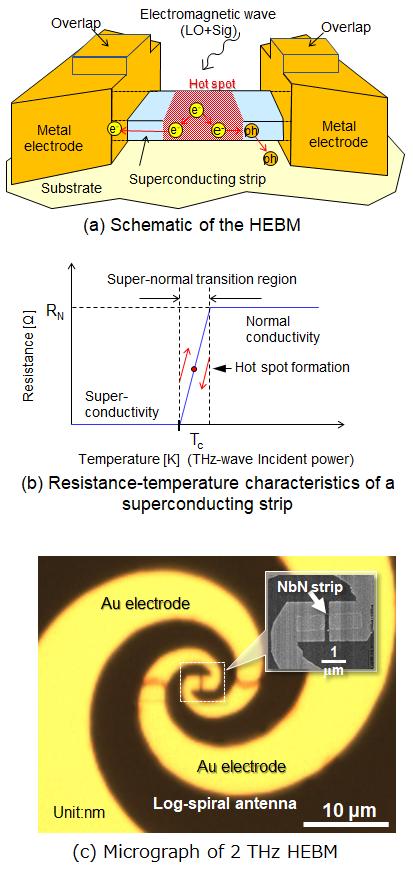Realized by NICT’s original superconducting device structure using magnetic materials

Credit: National Institute of Information and Communications Technology (NICT)
[Abstract]
The National Institute of Information and Communications Technology (NICT, President: TOKUDA Hideyuki, Ph.D.) has developed a unique superconducting hot electron bolometer mixer (HEBM) using magnetic materials. As a result, the noise of the 2 THz band heterodyne receiver has been reduced and the wide IF band has been achieved. The 2 THz band HEBM produced this time has a low noise performance of about 570 K (DSB), which is about 6 times the quantum noise limit, and a wide IF band characteristic of about 6.9 GHz, which is about 3 GHz larger than the conventional structure HEBM. Both of these are world-class performance.
This technology is expected to contribute to the development of new frequency resources such as high-speed wireless communication, non-destructive inspection, global environment measurement, and radio astronomy as basic technology in the THz frequency domain, which is an undeveloped frequency domain.
[Background]
The terahertz frequency range is an unexplored region and is expected to be applied to high-speed wireless communication, nondestructive inspection, security, medical care, global environment measurement and radio astronomy. However, in order to realize them, it is important to first develop the fundamental technology of oscillation and detection technology.
So far, superconducting SIS mixers have reported excellent heterodyne receiver performance in the lowest noise and wide IF band in the frequency domain up to 1 THz. However, the upper limit frequency of its operation is considered to be about 1.5 THz, and a superconducting hot electron bolometer mixer (HEBM) is currently under research and development as a low-noise mixer element in the frequency region exceeding 1.5 THz.
It has already been reported that HEBM exhibits low-noise receiver operation below 10 times the quantum noise limit in the frequency region above 1.5 THz. However, HEBM had a problem to be solved for its application, because the IF bandwidth, which means the amount of information that can be processed at one time, is narrow. Compared to a superconducting SIS mixer that can secure an IF bandwidth of 20 GHz or more, HEBM was less than a quarter of that, at 3 to 5 GHz. The expansion of the IF bandwidth has great application merits, and there has been a demand for a wider IF bandwidth of HEBM.
[Achievements]
NICT has developed a new HEBM structure using magnetic materials as a detection technology, which is a basic technology for terahertz waves, in collaboration with the Advanced ICT Research Institute and the Applied Electromagnetic Research Institute under research collaboration at the Terahertz Technology Research Center. The new HEBM offers low noise performance and wide IF bandwidth at 2 THz.
HEBM has a structure in which a small superconducting thin film piece (superconducting strip) is placed between two metal electrodes and is a mixer that utilizes the strong impedance nonlinearity generated between the superconducting-normal transition (See Figure 1 (a)). This time, we have developed a new HEBM structure unique to NICT that inserts a nickel (Ni) thin film, which is a magnetic material, between the superconducting thin film and metal electrode to leave superconductivity only in the superconducting strip between the electrodes (See Figure 2 (b)). This structure allows HEBM to be further miniaturized and has realized a wider IF band as well as lower detector noise.
Therefore, this time, we prepared a miniaturized HEBM with a superconducting strip length of 0.1 μm and achieved Trx = 570 K (DSB) as the mixer noise temperature corrected for the loss of the input optical system at the measurement frequency of 2 THz. This is an extremely low noise operation that is about 6 times the quantum noise limit. In addition, the IF bandwidth of about 6.9 GHz, which is about 3 GHz larger than that of the conventional HEBM, was obtained, and it was confirmed that the new HEBM structure using magnetic materials is effective in improving the receiver performance (See Figure 3). These results are the results of evaluation at the actual operating temperature of 4 K, and we believe that they have the world’s top-level performance as a terahertz band HEBM.
[Future Prospects]
NICT is working on the development of waveguide HEBM with the aim of commercializing 2 THz band HEBM. We aim to apply it to remote sensing technology such as global environment measurement and radio astronomy.
###
Media Contact
HIROTA Sachiko
[email protected]
Original Source
https:/




